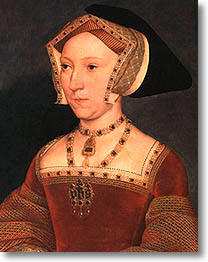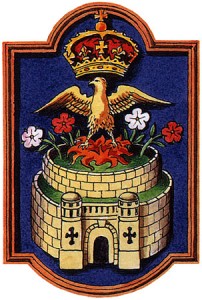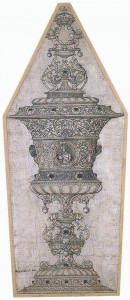On this day in history, Henry VIII and Jane Seymour were married by Archbishop Cranmer in a private ceremony in the Queen’s Closet at Whitehall Palace.
Henry’s third wedding came only eleven days after the execution of his second wife, Anne Boleyn.
As part of the preparations for the royal wedding, Anne’s falcon badges were hurriedly replaced with Jane’s personal emblem, ‘a phoenix rising from a castle amid flames and Tudor roses painted in red and white’ (Weir, Pg. 343) and her initials removed to make way for her successor’s.
The job was completed in such a hurry at Hampton Court that the ‘As are still visible underneath the Js’ (Weir, Pg. 343).
As for the actual wedding vows, David Starkey states that they would have been the same at each of Henry’s marriages. The King swore first:
‘I, Henry, take thee to be my wedded wife, to have and to hold from this day forward, for better for worse, for richer for poorer, in sickness and in health, till death do us part, and thereto I plight thee my troth.’ (Pg. 6)
Then the Queen replied, ‘I take thee, Henry, to my wedded husband’, followed by the same vow as Henry’s but with the promise to be ‘bonny and buxom in bed and board’.
According to Alison Weir, Jane’s marriage to the king was marked by public celebrations afterwards (Pg. 7) but according to Jane’s biographer, Elizabeth Norton, the marriage was kept secret for a few days and, as with Henry’s marriage to Anne, ‘there was no official announcement…instead, Jane was gradually presented to the people as queen’ (Pg. 81).
After the wedding ceremony, Jane presided over the court for the first time seated in the Queen’s chair beneath the canopy of royal estate.
Later that day, ‘the King made her a grant of 104 manors in 4 counties, as well as a number of forests and hunting chases, for her jointure, the income that would support her during her marriage’ (Weir, Pg. 344).
Henry also gave his new bride a gold cup designed by Hans Holbein. The king and queen’s initials are entwined with a love knot and Jane’s motto ‘bound to obey and serve’ appears three times in the design (Weir, Pg. 344).
A drawing of the design of the cup is all that survived, as Charles I pawned the original in 1625 and it was then melted down in 1629.
The drawing is now held at Ashmolean Museum in Oxford.
And what of the public’s reaction to the king’s third marriage? Elizabeth Norton claims that Jane’s wedding did not attract the hostility that her predecessor’s did but states that there were those that were less than impressed.
One John Eynsham was charged with claiming that ‘the king, for a frawde and a gilte, caused Master Norrys, Mr Weston, and the Queen [Anne] to be put to death because he was made sure unto the Queen’s Grace [Jane] that now is half a year before’ (Norton, Pg. 81).
There may have been others that shared his view but that were unwilling to speak out and risk being arrested.
Within the week Henry VIII made perfectly clear what he was hoping for, speaking of ‘the Prince hoped for in due season’ (Weir, Pg. 344).
Click here for a photo of the marriage deed drawn up for Henry’s marriage to Jane and currently housed at the Wiltshire and Swindon History Centre.
References Norton, E. Jane Seymour: Henry VIII’s True Love, 2009. Starkey, D. Six Wives: The Queens of Henry VIII, 2003. Weir, A. The Six Wives of Henry VIII, 2007.



















His hasty marriage has always seemed so horrible to me. I can’t imagine why such a rush,except maybe he was truly losing his virility and time was not on his side. And her, well, she must carry some of the burden for all those executions, too.